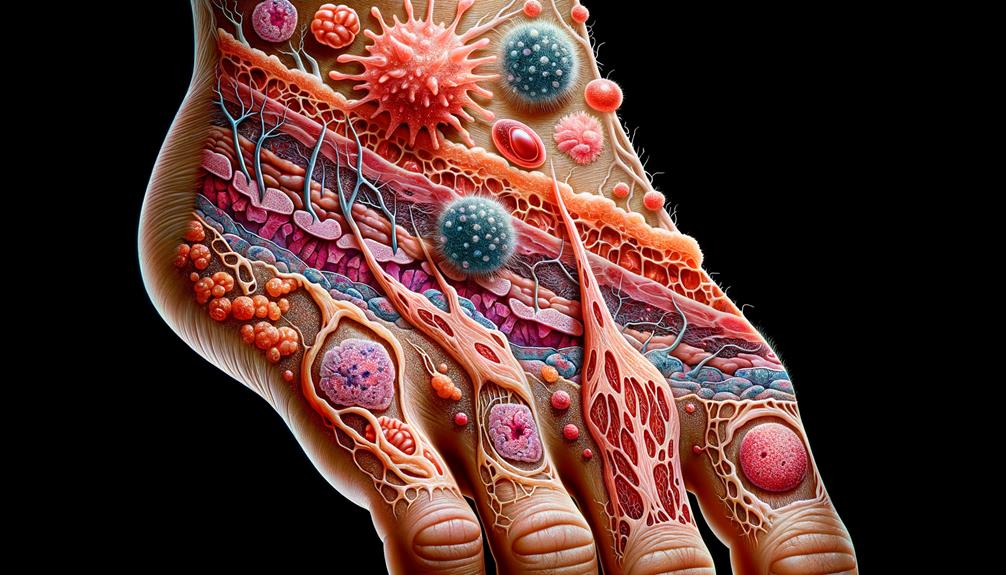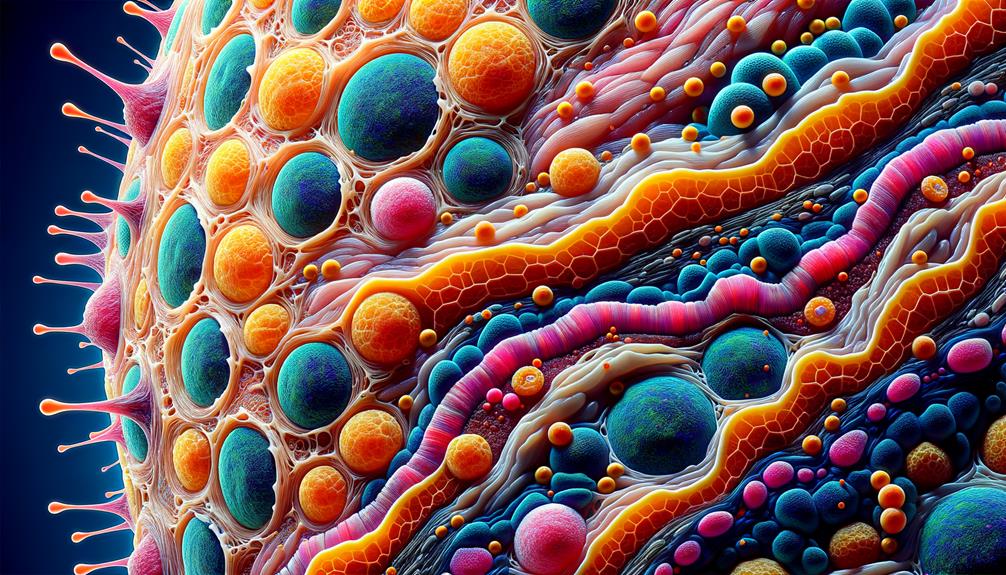Skin shedding, also known as desquamation, is a vital process for skin renewal. The epidermis constantly produces new cells in the stratum granulosum, which then move upward to form the outer layer, the stratum corneum. As they reach the surface, keratinocytes differentiate and cornify before eventually shedding off. However, environmental factors, infections, or conditions like eczema and psoriasis can disrupt this natural cycle. Calcium-dependent pathways and corneodesmosomes regulate cell detachment. To manage abnormal shedding, it’s crucial to keep the skin hydrated, avoid irritants, and address underlying causes. By understanding the mechanisms behind skin shedding, we can better address issues related to this process.
Key Takeaways
Skin shedding, also known as desquamation, is a natural process where dead skin cells are removed from the epidermis. The outermost skin layer, the stratum corneum, plays a vital role in this skin renewal process. New skin cells are produced in the stratum granulosum and then migrate to the surface. However, environmental factors, medical conditions, and infections can disrupt this normal process of skin shedding. To manage abnormal skin shedding, it’s crucial to stay properly hydrated and practice gentle skin care.
Understanding Skin Shedding
Skin shedding, or desquamation, is a natural process where our skin’s outermost layer is constantly replaced with new cells. This renewal process is crucial for maintaining healthy skin. The epidermis, the outermost layer of our skin, plays a key role in this process. Within the epidermis, the stratum corneum is the specific layer where dead skin cells accumulate and are eventually shed.
New skin cells are generated in the stratum granulosum and gradually move up through the epidermis, replacing dead skin cells that have served their purpose. As these dead cells slough off, they make way for fresher, more vibrant cells. This continuous cycle keeps our skin looking fresh and feeling smooth. It’s a remarkable natural process that ensures our skin remains resilient and capable of protecting us from environmental stresses.
Understanding skin shedding allows us to take better care of our skin, adopting practices that support this constant renewal and enjoying the benefits of healthy, glowing skin.
Causes of Skin Sloughing

To understand why our skin sheds, we need to explore the various factors that trigger this natural process. Our skin is constantly renewing itself, and this renewal involves the shedding of dead cells from the outermost layer of the epidermis. This process, known as desquamation, is crucial for maintaining healthy skin. Dead cells accumulate and eventually peel off, making way for new cells to take their place.
Several factors can speed up this shedding. Environmental influences, such as sunburn or extreme temperatures, can cause skin to peel. Certain medical conditions, like eczema or psoriasis, disrupt the normal cell turnover process, leading to excessive shedding. Contact dermatitis, an allergic reaction to substances like poison ivy or certain chemicals, can also cause the skin to peel as the body tries to get rid of the irritant.
Infections, both bacterial and fungal, can prompt the skin to shed as well. Some medications, including certain antibiotics and chemotherapy agents, may cause the skin to peel as a side effect. Understanding these triggers helps us appreciate the dynamic nature of our skin and its ability to adapt and protect us. With this knowledge, we can better care for our skin and ensure its optimal functioning.
Cellular Mechanisms

At the cellular level, the skin’s protective barrier relies on a meticulously regulated process of differentiation and cornification, where keratinocytes move through distinct layers. Starting from the stratum basale, they progress up through the stratum spinosum and stratum granulosum, ultimately reaching the outermost layer, the stratum corneum. Here, keratinocytes transform into corneocytes, forming a tough, protective layer.
Calcium-dependent signaling pathways play a vital role in this process, ensuring keratinocytes properly differentiate and cornify. This is crucial for the skin’s barrier function, which shields the body from environmental threats. The process of shedding dead skin cells, known as desquamation, occurs when corneodesmosomes, the structures that hold corneocytes together, break down.
However, when this process malfunctions, it can lead to skin diseases marked by peeling skin and visible scales. Conditions like psoriasis, atopic dermatitis, and toxic epidermal necrolysis disrupt normal desquamation, causing an accumulation of dead cells on the surface. Understanding these cellular mechanisms is vital to grasping how our skin renews itself and maintains its integrity.
Managing Abnormal Shedding

Effectively managing abnormal skin shedding requires identifying and treating the underlying cause, which often involves a combination of medical therapies and lifestyle adjustments. Conditions such as eczema, psoriasis, and fungal infections can cause abnormal desquamation. Consulting a dermatologist can help pinpoint the cause and develop a tailored treatment plan.
Hydration is crucial. Using gentle, fragrance-free moisturizers can improve the skin’s barrier and prevent further skin peeling. Warm water is a better choice than hot water for baths or showers, as it helps maintain moisture. Hot water can strip the skin of its natural oils, making abnormal desquamation worse.
| Factors | Management Tips |
|---|---|
| Over-exfoliation | Use gentle, moisturizing products |
| Extreme temperatures | Avoid hot water, use warm water |
| Immune system conditions | Seek dermatologist consultation |
| Irritants and sun exposure | Use fragrance-free moisturizers |
Avoiding known triggers, such as extreme temperatures and irritants, can help manage skin conditions. The immune system plays a significant role in conditions like psoriasis, where abnormal skin cells need to be removed. Keeping the skin hydrated and protected can improve overall skin health and manage abnormal shedding.
Treatment Options
Treatment options for peeling skin vary depending on the underlying cause. If the peeling is caused by jock itch or Toxic Shock Syndrome, antifungals or antibiotics may be necessary. For general skin hydration and integrity, fragrance-free moisturizing creams and ointments can be applied. Staying well-hydrated and using a humidifier can also help retain moisture in the skin.
Gentle skin care products and techniques can aid healing, and quitting smoking is crucial as it can damage skin and slow recovery. Avoid picking or pulling off peeling skin, as this increases the risk of infection.
A proper diagnosis and treatment by a dermatologist are vital to halt the peeling and prevent further complications. Medications like corticosteroids or NSAIDs may be prescribed to reduce inflammation and promote skin repair.
The outer layer of our skin, the epidermis, undergoes constant renewal. This process involves the stratum spinosum and granular layer, where cells mature and eventually become dead cells that reach the surface. Understanding this process can help identify the underlying cause of peeling skin and inform the most effective treatment approach.
Frequently Asked Questions
What Is the Process of Skin Cells Shedding?
The process of skin cell shedding, known as desquamation, is a natural and essential part of maintaining healthy skin. As dead cells from the epidermis flake off, new cells from the basal layer replace them, preventing issues like dullness, roughness, and clogged pores. This continuous cycle ensures that our skin looks and feels its best.
What Is the Process of Shedding Skin?
We shed around 500 million skin cells every day. This process involves new cells forming in the epidermis, pushing old ones to the surface, where they flake off, keeping our skin healthy and renewed.
How Does Skin Shedding Happen?
Skin shedding happens through a natural process called desquamation. At the base of my skin, new cells are constantly forming and pushing their way up. As they rise, they transform into keratinized corneocytes in the stratum corneum. Over the course of about 28 days, these cells eventually reach the surface and flake off, leaving my skin looking renewed and healthy.
What Is the Shedding Phase of the Skin?
The skin’s shedding phase happens every 28 days, similar to autumn leaves falling. New cells in the basal layer push upward, replacing dead cells, which keeps our skin healthy, unclogged, and resilient.



